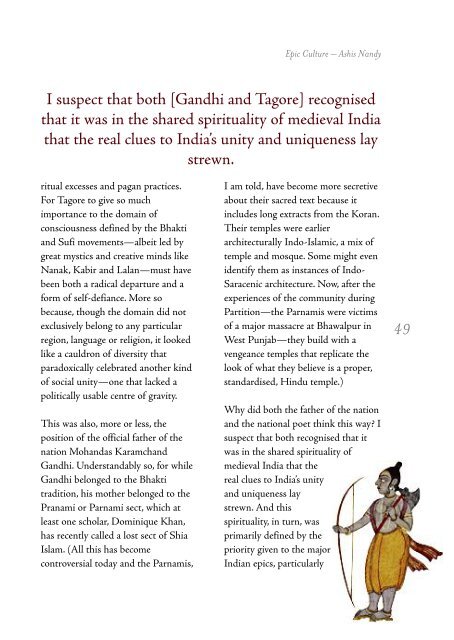Layout 3 - India Foundation for the Arts - IFA
Layout 3 - India Foundation for the Arts - IFA
Layout 3 - India Foundation for the Arts - IFA
You also want an ePaper? Increase the reach of your titles
YUMPU automatically turns print PDFs into web optimized ePapers that Google loves.
Epic Culture – Ashis Nandy<br />
I suspect that both [Gandhi and Tagore] recognised<br />
that it was in <strong>the</strong> shared spirituality of medieval <strong>India</strong><br />
that <strong>the</strong> real clues to <strong>India</strong>’s unity and uniqueness lay<br />
strewn.<br />
ritual excesses and pagan practices.<br />
For Tagore to give so much<br />
importance to <strong>the</strong> domain of<br />
consciousness defined by <strong>the</strong> Bhakti<br />
and Sufi movements—albeit led by<br />
great mystics and creative minds like<br />
Nanak, Kabir and Lalan—must have<br />
been both a radical departure and a<br />
<strong>for</strong>m of self-defiance. More so<br />
because, though <strong>the</strong> domain did not<br />
exclusively belong to any particular<br />
region, language or religion, it looked<br />
like a cauldron of diversity that<br />
paradoxically celebrated ano<strong>the</strong>r kind<br />
of social unity—one that lacked a<br />
politically usable centre of gravity.<br />
This was also, more or less, <strong>the</strong><br />
position of <strong>the</strong> official fa<strong>the</strong>r of <strong>the</strong><br />
nation Mohandas Karamchand<br />
Gandhi. Understandably so, <strong>for</strong> while<br />
Gandhi belonged to <strong>the</strong> Bhakti<br />
tradition, his mo<strong>the</strong>r belonged to <strong>the</strong><br />
Pranami or Parnami sect, which at<br />
least one scholar, Dominique Khan,<br />
has recently called a lost sect of Shia<br />
Islam. (All this has become<br />
controversial today and <strong>the</strong> Parnamis,<br />
I am told, have become more secretive<br />
about <strong>the</strong>ir sacred text because it<br />
includes long extracts from <strong>the</strong> Koran.<br />
Their temples were earlier<br />
architecturally Indo-Islamic, a mix of<br />
temple and mosque. Some might even<br />
identify <strong>the</strong>m as instances of Indo-<br />
Saracenic architecture. Now, after <strong>the</strong><br />
experiences of <strong>the</strong> community during<br />
Partition—<strong>the</strong> Parnamis were victims<br />
of a major massacre at Bhawalpur in<br />
West Punjab—<strong>the</strong>y build with a<br />
vengeance temples that replicate <strong>the</strong><br />
look of what <strong>the</strong>y believe is a proper,<br />
standardised, Hindu temple.)<br />
Why did both <strong>the</strong> fa<strong>the</strong>r of <strong>the</strong> nation<br />
and <strong>the</strong> national poet think this way? I<br />
suspect that both recognised that it<br />
was in <strong>the</strong> shared spirituality of<br />
medieval <strong>India</strong> that <strong>the</strong><br />
real clues to <strong>India</strong>’s unity<br />
and uniqueness lay<br />
strewn. And this<br />
spirituality, in turn, was<br />
primarily defined by <strong>the</strong><br />
priority given to <strong>the</strong> major<br />
<strong>India</strong>n epics, particularly<br />
49


